By Vinod Subbaiah | White Paper | March 16, 2023
Healthcare executive leadership teams are often tasked with managing the competing priorities of improving operational efficiency, enhancing productivity and staff retention, while reducing costs and limiting risk. Accomplishing just one of those goals can be quite challenging under the care conditions healthcare networks have faced in the years since the start of the global COVID-19 pandemic.
The key to overcoming these challenges is leveraging digital transformation to drive robotic process automation across every department in healthcare organizations. Healthcare workflows are defined as sequences of repetitive administrative, mental or physical tasks that need to be completed regularly by hospital operations staff, managers, and clinical teams.
According to Precedence Research, the global healthcare automation market was valued at $37.8 billion in 2021 and is projected to reach over $91.6 billion by 2030 with a compound annual growth rate (CAGR) of 10.33% predicted from 2022 to 2030. As of 2020, 90% of healthcare enterprises reported working to improve automation capabilities across its organizational footprint.
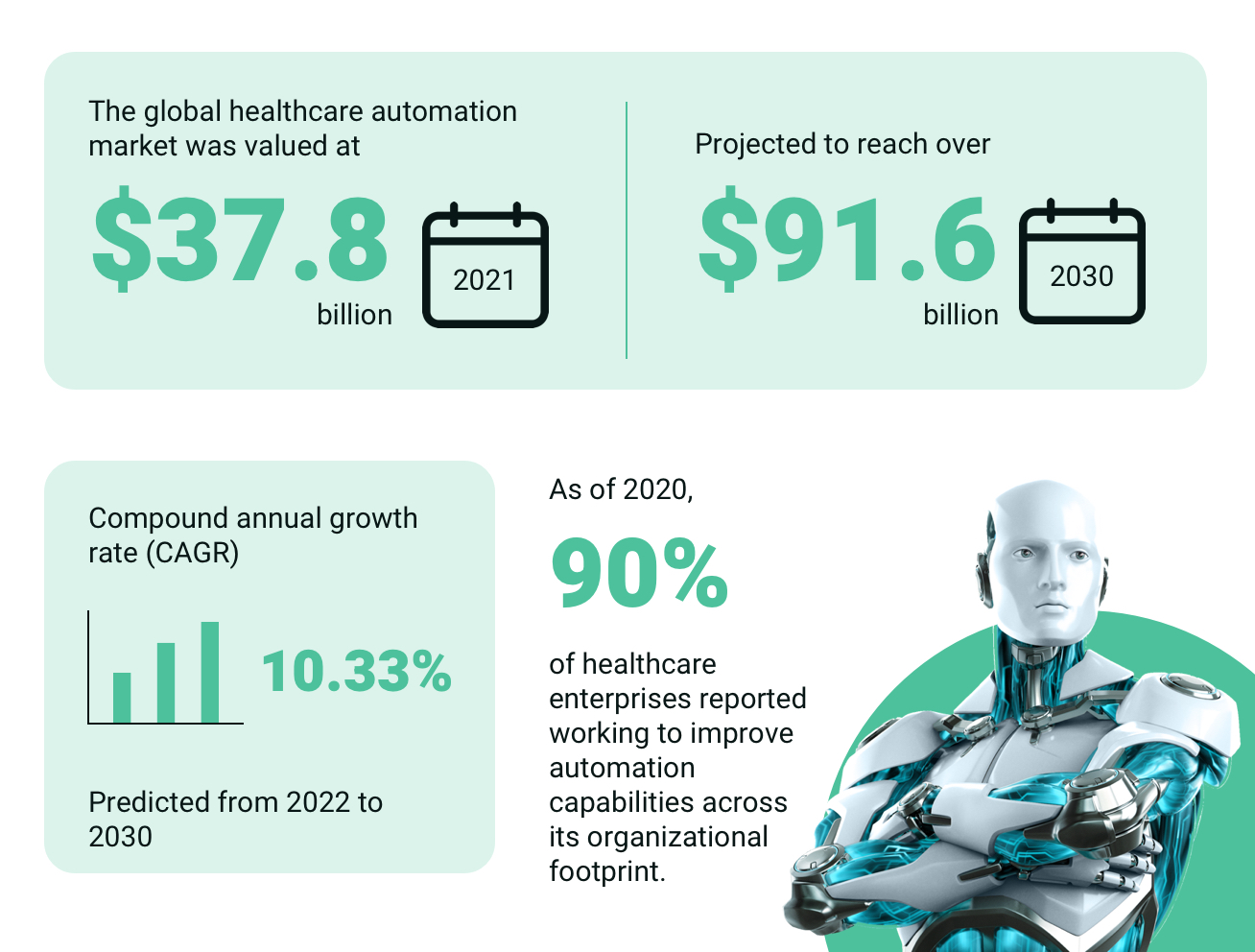
Looking ahead to 2023 and beyond, its clear healthcare organizations are going to continue strategic investments to improve robotic process automation, artificial intelligence, the use of real-time location systems (RTLS) and machine learning to streamline operations and improve clinical workflows.
Forward looking healthcare enterprises need end-to-end visibility into operations, medical, supply chain, staff management, and other core processes connecting different practice areas and departments across the community health landscape. This year, healthcare professionals will increasingly seek to automate core workflows to alleviate the burden of manual documentation processes and deliver more responsive communications to patients, payers, and other stakeholders in the healthcare matrix.
In the years ahead, successful healthcare organizations will continue to leverage robotic process automation to streamline hospital operations and enhance clinical efficiency. In this white paper learn more about how robotic process automation is transforming care delivery at the world’s largest healthcare enterprises.
Robotic Process Automation[RPA] in Healthcare
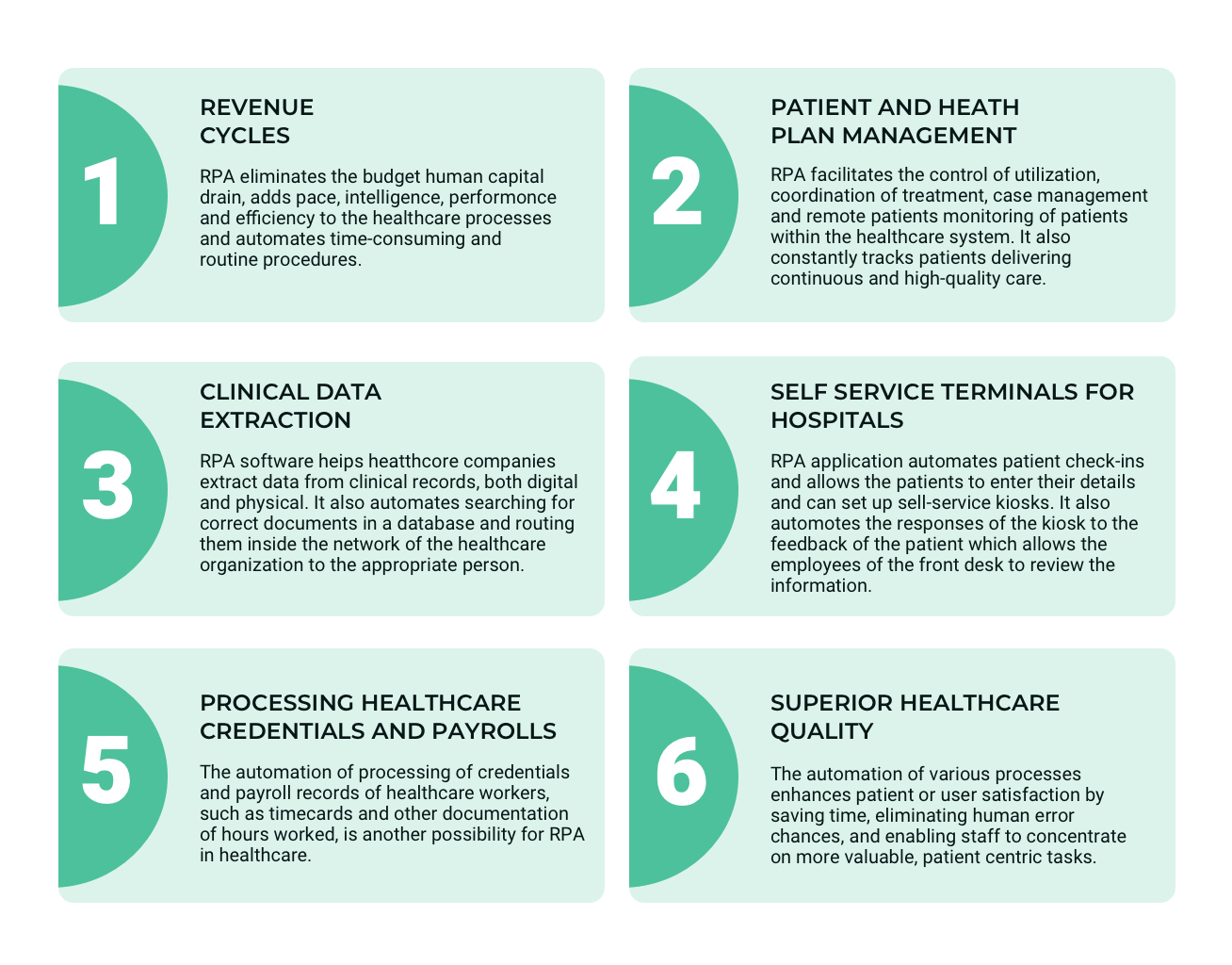
What is Robotic Process Automation?
The term robotic process automation (RPA) refers to the application of automated rules-based business processes. RPA has the ability to emulate repetitive human actions to dramatically streamline clinical workflows, increase efficiencies, and deliver a significant return on investment (ROI) and resource savings to drive increased revenues.
Robotic process automation is the means of automating tasks such as routine data entry but can also be used to simplify much more complex undertakings such as data extraction for decommissioning hardware servers or migrating patient records to cloud-based electronic health records (EHR) systems.
RPA extends the reach of human staff and allows teams to get things done in a fraction of the time it would normally take. Meanwhile, automated systems never need to take breaks, never tire of their work, and never need to stop for refreshments. Robotic process automation delivers the agility needed to scale operations while actually improving efficiencies and reducing the total cost of care.
Due to the fact that RPA automates core processes that are essential to business success, the ROI delivered after completing investment is nearly instantaneous. In today’s competitive practice environment, being able to move more nimbly, make decisions faster, and leverage automated rules-based decision making provides the competitive advantage needed to protect investments long into the future.
Four Ways to Program RPA Solutions
Manually Programming the RPA Solution: RPA solutions are controlled using the programming language they were written with. This approach delivers a highly responsive and user-specific deployment but requires domain area expertise to ensure a smooth healthcare software product release and update lifecycle. Programming instructions manually inputted by a software engineer define the processes and means the system communicates with organizational data.
Leveraging a Graphical User Interface to Control the RPA: Many healthcare IT vendors are releasing software that allows clinical teams to modify RPA systems using a simple drag and drop interface that is similar to other modern project management software tools. One of the main advantages of these solutions is that they can be controlled by staff that has been trained and does not require extensive technical domain expertise to be able to complete simple updates and feature modifications.
Recording Macro Functions to Scale Bot Behaviors: RPA solutions using machine learning have the ability to learn behaviors by recording them as macros. This works in a way similar to the way functions can be programmed into a platform like Excel. Macro functions can empower integrations between different pieces of software with one solution fetching a data set and another comparing results against historical attrition data.
Self-Regulating Machine Intelligence: At the most advanced practice levels, RPA solutions can be deployed that are self learning, self correcting, and self regulating to deliver continuous improvement by interpreting quality assurance and other key operational reports. Once these advanced RPA software solutions are deployed orchestrators act as intermediaries to ensure the automated processes are executed according to plan and the current needs of the organization.
Automation Extends the Reach of Human Capital
Robotic process automation is not meant to compete with human potential or take the jobs of clinical professionals or hospital operations staff. In the near future, advanced RPA solutions will be used to extend the reach of human capital and make better use of human talent to reduce staff burnout and increase the retention of high value staff.
In the wake of the COVID-19 pandemic, many healthcare organizations are realizing first hand how important it is to take care of the front line staff essential to their success. RPA acts as a means of easing the burden placed on human resources so that software services can do more of the heavy lifting and empower medical teams to focus on serving patients without being bogged down in paperwork, compliance obligation, and administrative complexity.
RPA empowers human resource professionals to provide workers with new employment and professional development opportunities. In the near future, hospitals will not need to employ as many professionals but will be able to function much more efficiently and productively. This will deliver a measurable revenue boost to providers while ensuring that patients have increased access to world class medical care.
Oftentimes, complex and time consuming tasks such as EHR data migrations, legacy technology stack archiving, end of year billing and account reconciliation services require the use of temporary workers or full-time equivalents (FTE) to manage increased work loads. In these situations, RPA provides the processing power needed to overcome challenges without having to add additional staff or cost to department budgets.
Hospital systems can reduce staff burnout by reducing the need for human resources to handle repetitive, time consuming, and difficult tasks. Virtual assistant solutions can even walk patients through administrative procedures that traditionally could have required a lot of face to face time with staff members. RPA allows human teams to focus attention where it is needed without wasting energy trying to serve the 10% of patients that require 90% of normal staff efforts to manage care.
RPA software solutions provide clinical teams with access to real-time visibility into organizational data to drive more efficient data-driven decision making. Automating clinical workflows to run during night time hours allows teams to run more efficiently and with less burdens during normally more busy daylight hours.
According to Deloitte’s Third Annual Global Robotic Process Automation Survey:
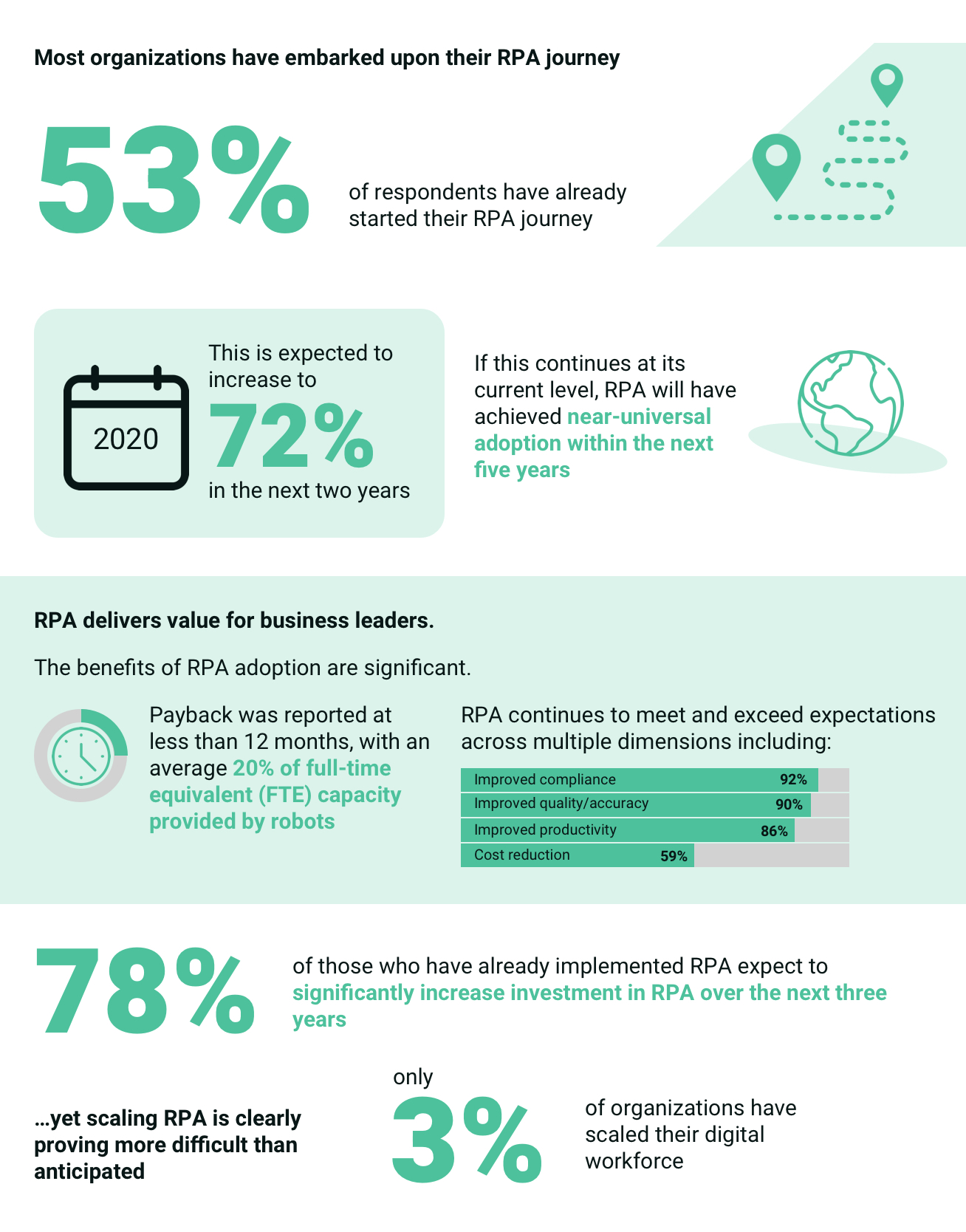
Key Benefits of Implementing Automation to Improve Clinical Workflows
Automation is transforming care delivery across the healthcare, medical, life science, and pharmaceutical landscape. Forward-looking organizations are leveraging automation capabilities to integrate core processes and improve the way the people, processes, and platforms driving their success work together on a daily basis.
Workflow automation in healthcare isn’t just a matter of saving time and money but actually offers the potential to save lives and improve care delivery at scale. As our human societies continue to confront the enduring legacy of the COVID-19 pandemic, it’s become clear to many executive leaders that completing digital transformation to improve clinical outcomes is a top line priority and galvanizing rallying point to unify organizational problem solving.
Here are some of the key benefits your healthcare organization can enjoy from delivering RPA software solutions to optimize core processes:
The Enterprise Agility Needed to Scale Business Models
RPA allows healthcare providers to automate repetitive tasks at scale to save tremendous amounts of time and money across their organizations. These benefits to productivity, time and cost savings, and workflow optimization allows healthcare orgs to prioritize resources where they are needed without sacrificing the ability to continue delivering the best-in-class care their clinical teams are known for. RPA unlocks the enterprise agility needed to optimize business performance successfully scale emerging business models.
The Quality Assurance and Regulatory Compliance Needed to Improve Clinical Efficiency
RPA software overcomes fatigue and conditions of human error which lead to massive inaccuracies in key data sets. RPA reduces the ability for data integrity issues to manifest in the form of mistakes which could endanger life or the ability to sustainably secure attractive profit margins. Automation processes operationalize quality assurance and compliance documentation to improve clinical efficiency and reduce the burden of time consuming manual paper work.
More Effectively Manage Human Capital
Many administrative , medical record keeping, and compliance documentation tasks in healthcare are extremely time consuming, repetitive, and boring yet essential for healthcare providers to complete. By freeing up employees to escape the burden of these tasks, they are empowered to use their time and talents more efficiently leading to reduced staff burnout, lower turnover rates, and increased retention of high value talent. RPA makes the most challenging parts of your business operate more smoothly, reducing the strain on staff and invigorating them to focus their attention on doing what really matters: delivering your patients the highest quality of healthcare services.
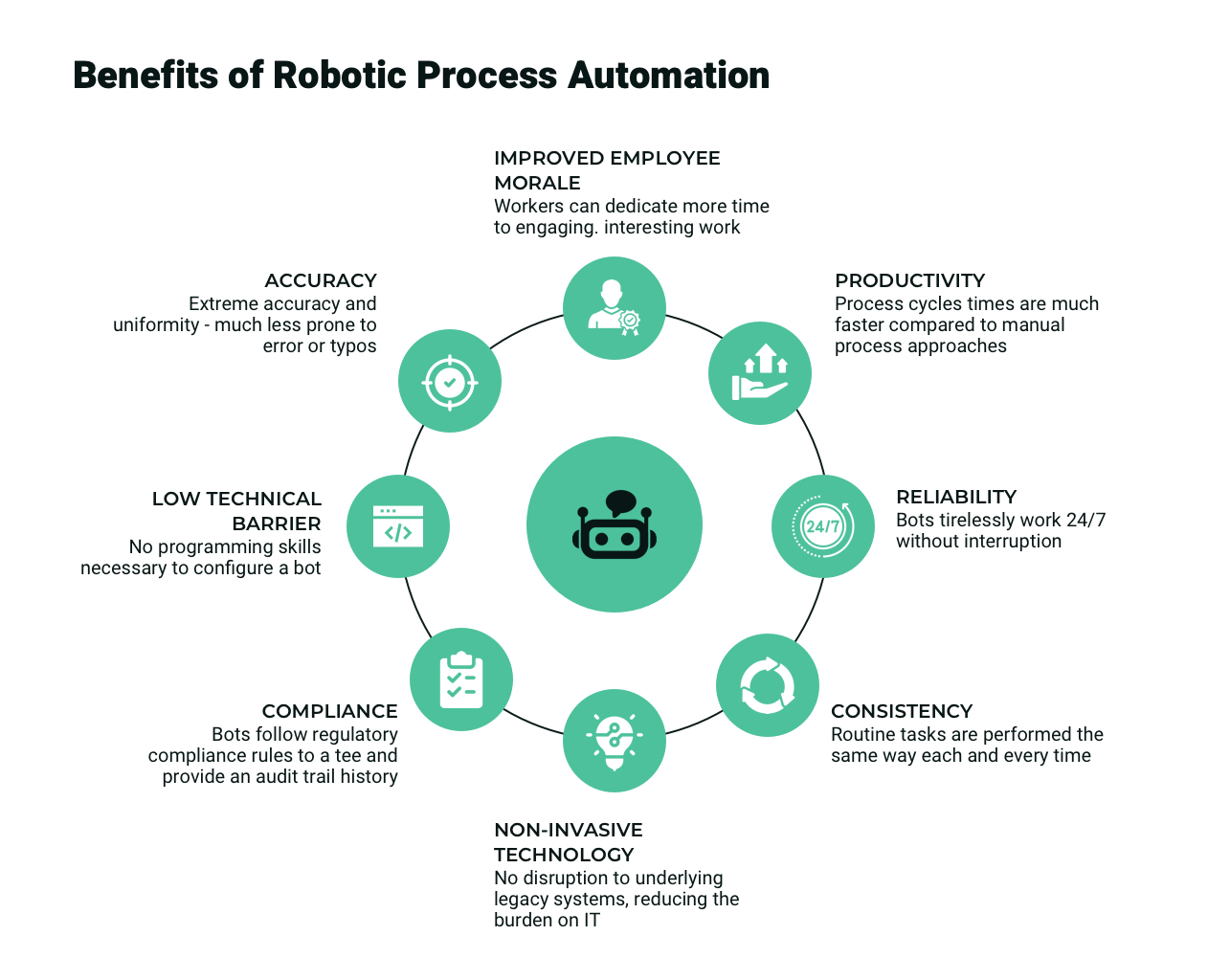
Measurable Cost Savings Leading to a Reliable ROI
The vast majority of healthcare organizations that complete RPA investments report measurable cost savings and a return on their investment in less than 12 months after adopting and implementing a robotic process automation solution. The measurable savings comes from a reduction in the cost of human capital and workforce utilization, reduced need for paper, spreadsheets, and other tools which in the past led to a huge waste in time and effort. RPA expedites core processes so that instead of chasing after patients and trying to get them on the phone, automated appointment setting services handle much of the process so that patients and providers both have a more smooth and seamless experience.
Harness Your Organization’s True Potential
The vast majority of healthcare organizations are bloated and overwhelmed with organizational processes that need to go the way of the dodo bird. Embracing change is never a simple or easy decision but after the last two years most management teams can accept that it’s finally time to make the changes necessary to leverage the full potential of digital transformation. By removing unnecessary processes and streamlining operations all over your organizational footprint your teams are empowered to focus their attention delivering your patients the highest quality of care.
How to Get Started with Robotic Process Automation
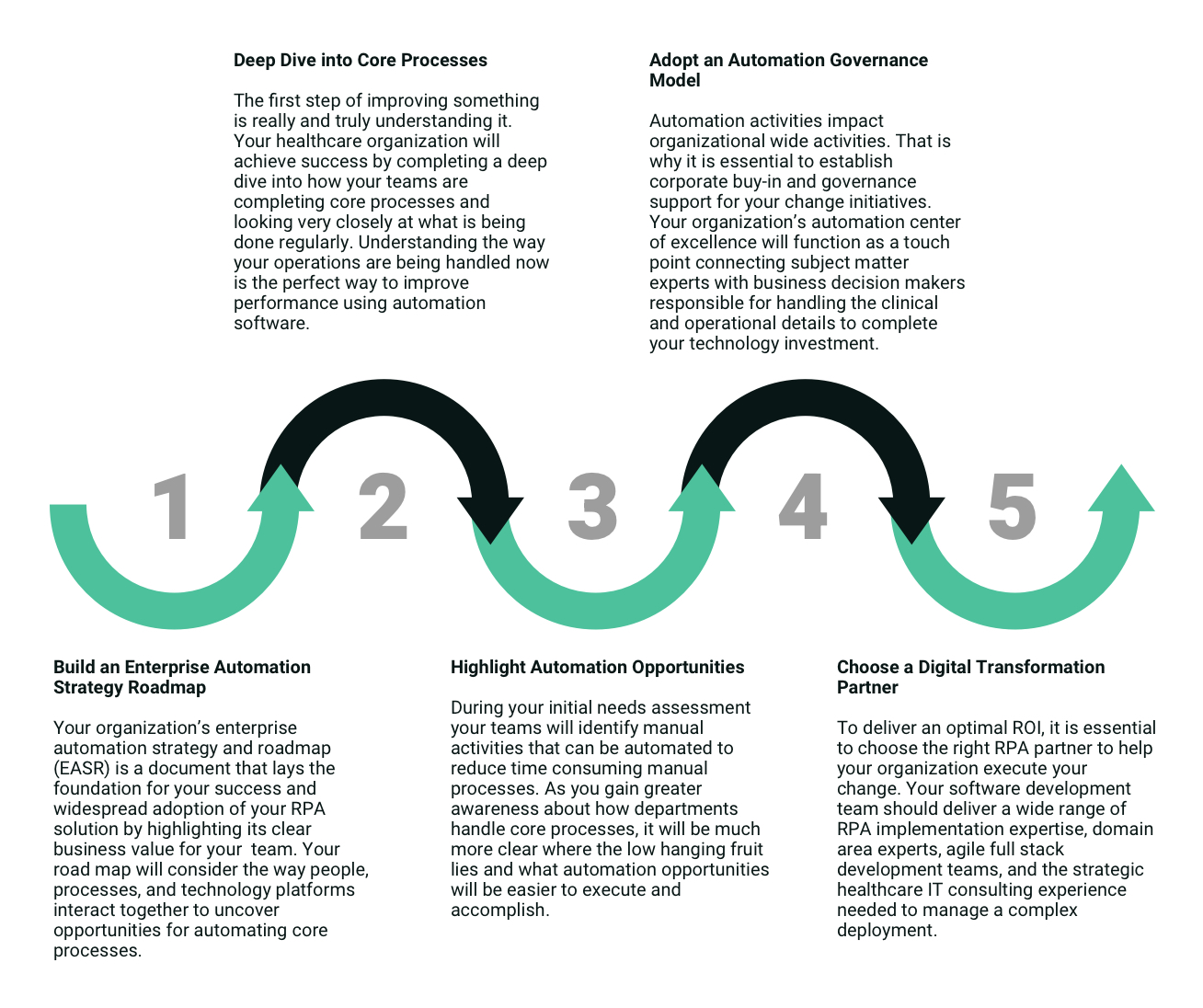
Deliver Automation to Streamline Clinical Workflows
Ready to get started? Perfect! Asahi Technologies is the custom healthcare technology service provider your organization can count on to deliver enterprise-wide automation solutions. Get in touch today to learn more about how to implement automation to streamline your organization’s clinical workflows.
Our Enterprise Automation Expertise
Unilever is a global leader in fast-moving consumer goods (FMCG) that was looking to build an application that would automate the data aggregation process for purchase price of raw materials, improving accuracy and presenting the results in a highly accessible and straightforward dashboard. They wanted to be able to analyze and present information in graph and chart form, and help its team remain proactive if certain supply chain metrics went above or below a set threshold with email notifications.
Unilever chose Asahi Technologies due to our expertise in creating automation tools. Our standing partnerships with UiPath and Automation Anywhere, two of the most significant automation service providers, also demonstrated we had the tools to help Unilever create the right solution.
